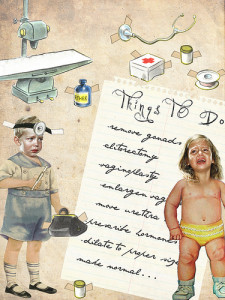SOCIAL MUTILATIONS. Scalpel increasingly popular to homologate atypicalities
English version by Lea Vittoria Uva.Â
Here the original by Michela Balocchi and Alba Maria Tonarti
Recently, incorrect and confusing information relating to the medical management of intersex variations or differences in sexual development (dsd, following and adapting the acronym of Disturbs of Sexual Development, DSD), has been spread on several online newspapers.
Totally misleading and sensationalist headlines ranged from “Children with âuncertain sexâ, in San Camillo surgery boom: plus 50 per cent in 5 years” (la Repubblica Roma.it), to “Boom of children with âuncertainâ sex. In Rome, an increase of 50 percent “(Leggo.it), to “Boom of sex-change operations, newborns in first place” (young.it).
There are many details to be explained about the titles and contents of the above articles. We will only address those we consider most urgent and essential.
When we speak of children with “uncertain sex”, we refer in a simplistic and inaccurate way to a variety of biological forms and differences of those who are born with sex chromosomes, genitalia, gonadal, and/or secondary sexual characteristics that vary from what is traditionally regarded as male or female. According to the biologist Fausto-Sterling (2000), based on studies carried out on the data available to date, 1.7% of newborns have some form of intersex variability (chromosomal, gonadal, hormonal or anatomical).
In presence of genitalia not clearly identifiable as male or female at birth, it became practice, from the middle of the last century, to subject many newborns to surgical procedures on genitals to be conformed to the dual model of the sexes: female – male.
 The pathologization of intersex variability, and the induced invisibility caused by the forced adaptation to one of two genders, is not present in all cultures (Baird), but in sociocultural systems based on a narrow binarism of sex-gender; the parameter that defines the condition of “normality” is identified with the duality of male/female – man/woman. The medicalization is thus applied to all intersex conditions that do not conform to sexual binarism, even in the absence of health reasons.
The pathologization of intersex variability, and the induced invisibility caused by the forced adaptation to one of two genders, is not present in all cultures (Baird), but in sociocultural systems based on a narrow binarism of sex-gender; the parameter that defines the condition of “normality” is identified with the duality of male/female – man/woman. The medicalization is thus applied to all intersex conditions that do not conform to sexual binarism, even in the absence of health reasons.
In the above articles, therefore, speaking of “babiesâ sex change” creates confusion between two rather distinct realities: the one of the so-called “gender dysphoria” (GID, or transsexuality/transgenderism) and the one of “differences of sex development” (DSD, intersex).
This means that the followings are put on the same level: (a) surgical procedures for the adaptation of the body (and its primary and secondary sexual characteristics) to someoneâs gender identity, carried out on adults aware of their GID, self-determined and legitimately protected by law (164/82), and on the other hand (b) cosmetic surgery on unaware infants and children, unnecessary for their health but still practiced in some hospital settings in order to “normalize” a genital atypicality (read and interpreted as a “psycho-social emergencyâ) according to protocols that are widely questioned from a medical and scientific standpoint and already obsolete on an international level.
From the articles, people can read and take for granted, without any opposition, the validity of early surgery as the only way of solution in case of atypical genitals at birth, to the point that âquotation marksâ in the article report: “Over the past 5 years we have performed more than 350 interventions of this kind on children below 6 years of age, […] to give hope to so many people and parents […].”
The medical protocols of early surgery or early drug treatment in cases of intersex/DSD draw on Moneyâs theories, dating back to the second half of the last century, on the psycho-sexual neutrality of the infant until the early years of life and the alleged beneficial effects of reconstruction into a female or a male genitalia on the mental and physical health of the child; theories that have now been amply demonstrated to lack validity and to be scientifically and medically fallacious (Diamond-Sigmundson; Dreger, Fausto-Sterling; Wiesemann).
 These protocols and surgical practices have also been strongly contested in the early nineties by the same intersex people who have been subjected to them and who report the irreversible, painful, mutilating and traumatizing effects, as well as the sense of shame and stigma for being made ââto feel sick, wrong and different only for the appearance of their genitals.
These protocols and surgical practices have also been strongly contested in the early nineties by the same intersex people who have been subjected to them and who report the irreversible, painful, mutilating and traumatizing effects, as well as the sense of shame and stigma for being made ââto feel sick, wrong and different only for the appearance of their genitals.
Not to mention the devastating effects in cases of mal-assignment of sex/gender, where the sex assigned to the infant through corrective surgery on genitals and/or pharmacological therapy does not correspond to gender identity developed: in these cases the person will end up living in disharmony between body (modified from ânormalizingâ therapies) and gender identity, similarly to trans people (Chase/Laurent, Devore, Viloria).
Recently, following the two Intersex Global Forum organized by Ilga-Europe in 2011 and in 2012, participants made very clear and explicit demands of non-discrimination against intersex people/dsd, aimed at “guaranteeing them the right to the integrity of their body and self-determination” and to “put an end to the practice of ânormalizationâ and mutilation, such as genital surgery, unsolicited medical and psychological treatment, infanticide and selective abortions (based on intersexuality) that still occur in some parts of the world.”
In this respect, the National Committee for Bioethics in Italy, in 2010, also encouraged postponing any surgery and/or hormone treatments to allow the active participation of the subject in the decision. And the recognition of the fundamental role of the patient is also enshrined in the guidelines resulted by the International Consensus Conference in 2006, as well as the guidelines proposed by Wiesemann (2010) where the first point urges one to keep in mind that the patient is the only one to decide on their gender identity: “Science has abandoned the idea that gender identity can be completely malleable through surgery, socialization or education. The way in which gender identity is formed is not fully understood: genetic, hormonal, psychological factors play an important role. In the long run, the patient is the only one to know how he/she is or wants to be. In a number of intersex conditions, such as deficiency of 5-alpha reductase inhibitor or gonadal dysgenesis, there are high chances that a change of gender identity can occur during or after puberty” and invites you to consider point 4: âDo not put aesthetics first. When an intersex condition is discovered in the early months of life, parents and caregivers are especially and primarily concerned about the atypical appearance of the external genitalia. The attempt to normalize the external genitalia is an understandable reaction. But there are other more important objectives for the clinical activity, such as the prevention of suffering or the increasing of self-confidence of the patient. In some cases, suffering is only a problem of the parents, not the child; therefore parents need to be supported to deal with the situation. Aesthetic criterion alone does not offer a reasonable justification for an intervention.”
Going back, then, to the bad sensationalist pages of the past few days and summarizing: cosmetic surgeries wanted and desired by the concerned person are one thing (both for trans people and for young or adult intersex people who so request), those are legitimate and important surgeries that must be granted; âcorrectiveâ cosmetic surgery on children and babies unable to express themselves about it and whose gender identity can not be known with any certainty until they are so young, is another thing entirely.
In Italy, the serious and widespread misinformation on the subject is likely to condemn to invisibility people with chromosomal, gonadal or anatomical forms of intersexuality, and to keep pathologizing anyone who wants to live their corporeal reality without having to change the look just to comply with the social pressures of the binarism of sex/gender.
For this reason we urge the media to pay more attention and respect in dealing with this as with other sensitive and complex issues, we urge professionals in the field, to consider the changes in medical protocols and guidelines at international level, and we urge institutions to invest public funds not for the irreversible cosmetic surgery on the genitals of infants and children, but instead to start tracking the reality of intersex/dsd in our country in the interest of protecting the dignity of the person, and at the same time to raise awareness of public opinion and experts on a reality that is still made invisible and taboo.
We ask all this for the sake of diversity, of knowledge, of the principle of self-determination and the right to physical and mental integrity of each individual, as sign of a culture of understanding and acceptance of the other.
Dr. Michela Balocchi, PhD in Sociology and Political Sociology, Researcher
Dr. Alba Maria Tonarti, Surgeon, Child Neuropsychiatrist, Psychotherapist






